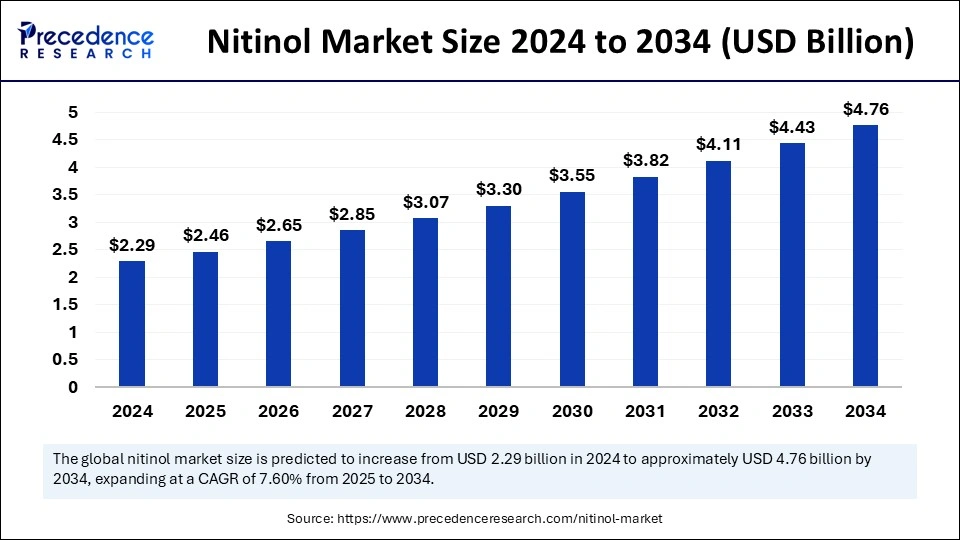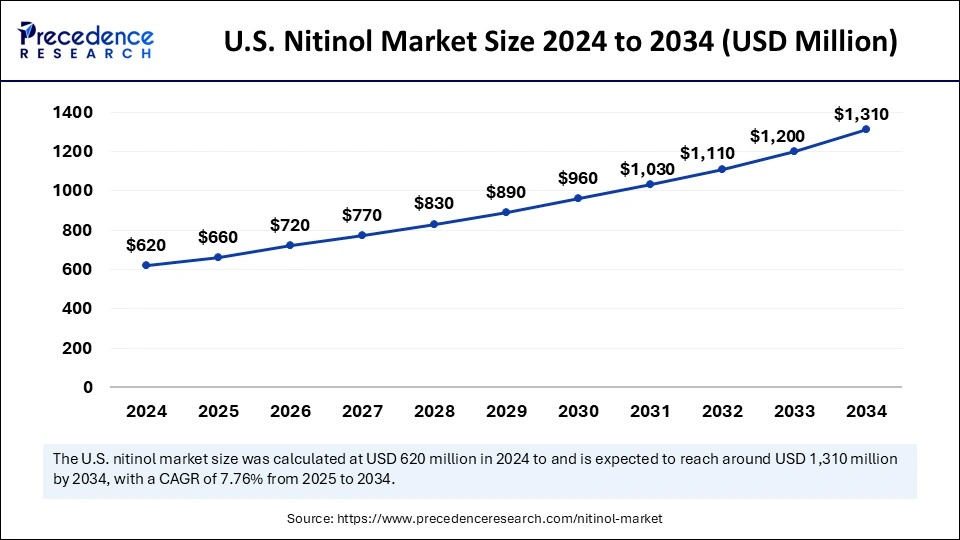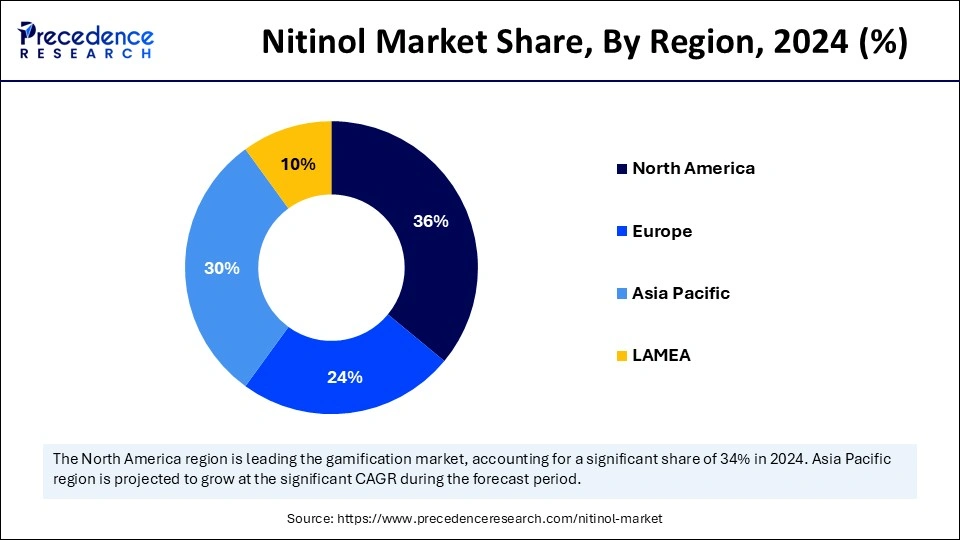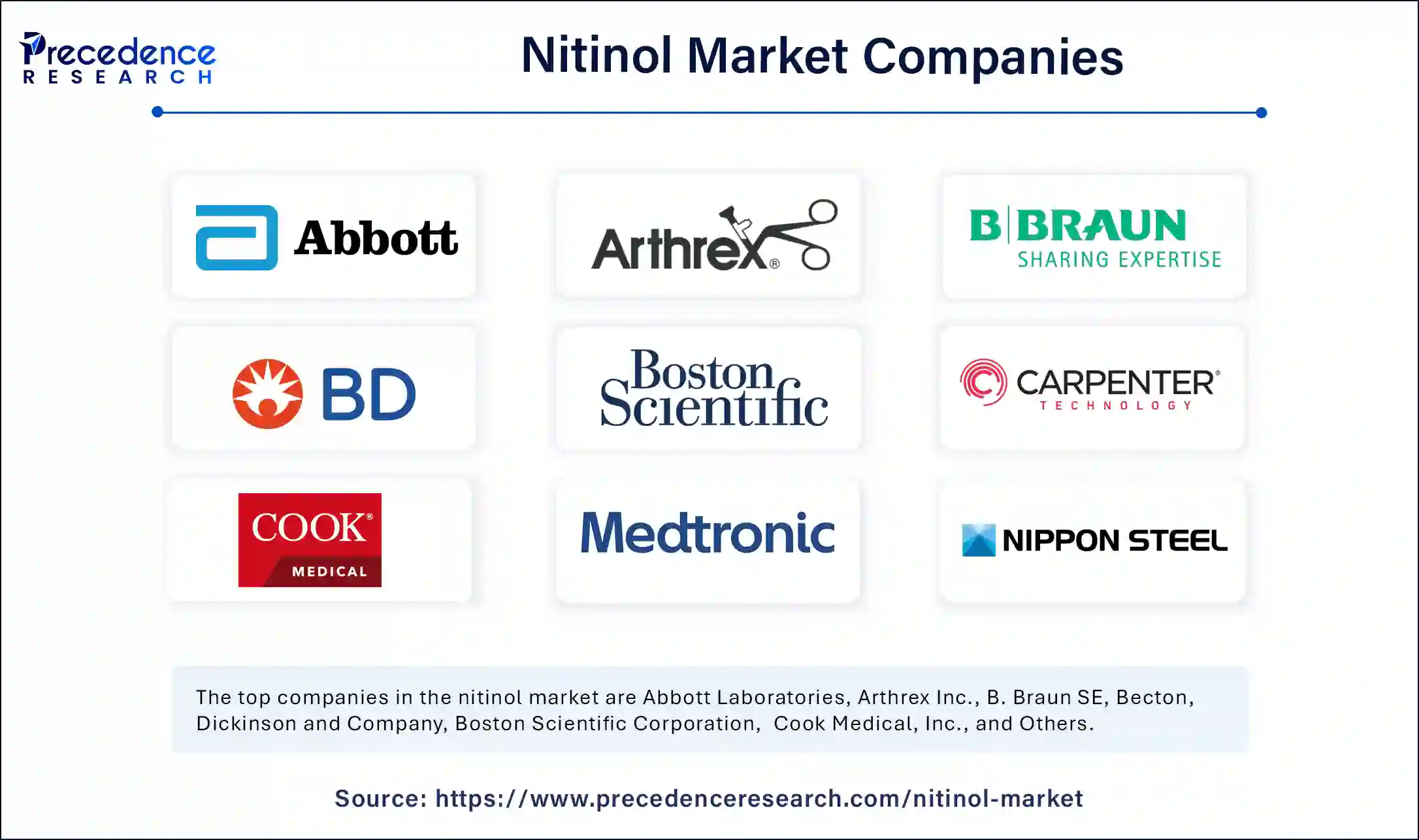The global nitinol market size is calculated at USD 2.46 billion in 2025 and is forecasted to reach around USD 4.76 billion by 2034, accelerating at a CAGR of 7.60% from 2025 to 2034. The North America market size surpassed USD 820 million in 2024 and is expanding at a CAGR of 7.81% during the forecast period. The market sizing and forecasts are revenue-based (USD Million/Billion), with 2024 as the base year.
The global nitinol market size was estimated at USD 2.29 billion in 2024 and is predicted to increase from USD 2.46 billion in 2025 to approximately USD 4.76 billion by 2034, expanding at a CAGR of 7.60% from 2025 to 2034. The rising utilization of nitinol in various industries like healthcare, aerospace, and automotive is expected to boost the growth of the nitinol market throughout the forecast period.

Artificial intelligence (AI) is transforming the landscape of various industries. AI is beneficial for improving the nitinol manufacturing processes. AI-based tools can help predict defects in the formation of nitinol-like balling. This helps manufacturers make informed decisions and change their processes to avoid defects in the final products. AI and machine learning (ML) can analyze huge amounts of data to help determine the best processes for nitinol manufacturing, optimizing the design of nitinol products. AI also helps improve the quality as well as the production capacity of nitinol. Moreover, AI technologies help in boosting research and development activities. AI can analyze vast datasets to find out what compositions are biocompatible, helping researchers focus on outcomes that are more likely to succeed.
The U.S. nitinol market size was exhibited at USD 620 million in 2024 and is projected to be worth around USD 1,310 million by 2034, growing at a CAGR of 7.76% from 2025 to 2034.

North America dominated the nitinol market with the largest share in 2024. This is mainly due to the presence of a large number of key players in the region. The region’s well-established healthcare, automotive, and aerospace industries have increased the adoption of nitinol in various components and devices. There is a high demand for medical devices. The rise in the number of cases of cardiovascular and other chronic diseases is expected to sustain the region’s dominance in the coming years.
The U.S. stands out as a major contributor to the North American nitinol market. This is mainly due to its well-established healthcare system, providing coverage for medical devices. The rising geriatric population further supports market growth since older adults are more prone to chronic diseases, which often require surgical intervention. Moreover, there is a high demand for minimally invasive surgeries, contributing to market growth.

Asia Pacific is expected to witness the fastest growth during the forecast period. The rising production of automotive components is a key factor boosting the demand for nitinol. There is a rising healthcare expenditure, supporting market growth. Governments of various Asian countries like China, Japan, and India are investing heavily in modernizing the healthcare infrastructure through the adoption of advanced technologies. The expanding healthcare facilities and automotive industry further support regional market growth. Moreover, the rising cases of chronic diseases and high demand for medical devices contribute to regional market growth.
Europe is considered to be a significantly growing area. The well-established healthcare infrastructure in the region is facilitating the higher adoption of nitinol-based medical devices. The rising geriatric population, coupled with the increased prevalence of chronic diseases, is supporting market growth. An increase in investments from the government and private organizations to strengthen the healthcare infrastructure, rising spending on healthcare, and increasing demand for surgical devices are expected to drive the growth of the European nitinol market.
Nitinol is an alloy that is mainly composed of nickel and titanium. It has the ability to be able to return to its original shape after deformation with specific temperatures. This flexibility of nitinol offers a broad scope of applications across different industries. The benefits of resilience, adaptability, and flexibility make it a popular choice for applications that require durability. Nitinol is widely utilized in the medical and healthcare fields. Devices like stents and guidewires are made from this substance, which helps improve the components' durability and flexibility.
With the rising cases of chronic diseases and the increase in surgical procedures around the world, the demand for nitinol tubing is increasing, which is expected to boost the growth of the nitinol market during the forecast period. The rising investments in expanding and strengthening healthcare infrastructure further support market growth. Aerospace and automotive industries also use nitinol in various components. Technological advancements in the manufacturing processes have enabled consistent quality and optimization of production, aiding this market growth. Key players are investing in research and development efforts to broaden the scope of applications of nitinol, contributing to market expansion.
| Report Coverage | Details |
| Market Size by 2034 | USD 4.76 Billion |
| Market Size in 2025 | USD 2.46 Billion |
| Market Size in 2024 | USD 2.29 Billion |
| Market Growth Rate from 2025 to 2034 | CAGR of 7.60% |
| Dominating Region | North America |
| Fastest Growing Region | Asia Pacific |
| Base Year | 2024 |
| Forecast Period | 2025 to 2034 |
| Segments Covered | Type, Product, Application, and Regions. |
| Regions Covered | North America, Europe, Asia-Pacific, Latin America, and Middle East & Africa |
Increasing Surgical Procedures
With the increasing prevalence of chronic diseases like cardiovascular diseases, cancers, and inflammatory bowel disease (IBD), the burden of surgical procedures is rising. Cardiovascular diseases often require surgical intervention to manage conditions. This, in turn, boosts the demand for advanced medical devices, in which nitinol plays a crucial role. As surgical procedures rise, the need for medical devices used in surgical procedures also increases. Due to its unique properties, nitinol is widely used in stents, guidewires, and other surgical instruments. In addition, the rising geriatric population around the world drives the growth of the market. Geriatric people are more prone to chronic diseases, requiring surgical interventions.
High Costs of Raw Materials and Complex Production Process
The high costs of raw materials, such as nickel and titanium, hamper the growth of the nitinol market. Fluctuations in the prices of raw materials affect production costs, reducing profitability for manufacturers. The complex manufacturing process of nitinol further adds to its high production. Establishing infrastructure and following guidelines for the intricate production process of nitinol is daunting. Small and medium-sized organizations may be reluctant to invest in nitinol. Moreover, the production of nitinol is still limited, resulting in high costs. Key players must focus on research and development efforts to help scale the production process to boost the availability of nitinol.
Rising Demand for Minimally Invasive Surgeries
The rising demand for minimally invasive procedures creates immense growth opportunities in the nitinol market. There is a significant rise in the demand for minimally invasive surgery, boosting the demand for nitinol-based medical devices. Nitinol has unique features that make it suitable for medical devices like stents. These are widely utilized for cardiovascular surgeries. These devices are preferred due to their faster recovery time, smaller incisions, and reduced complications. These devices drastically improved patient outcomes, helping patients feel more comfortable with cardiovascular surgical procedures. Furthermore, the rising investments in improving healthcare infrastructure, especially in emerging countries like China and India, are expected to propel the market in the upcoming period.
The 1-way memory effect segment dominated the nitinol market in 2024. In this effect, a malformed nitinol can return to its original shape when heated at a specific temperature. This helps transform the nitinol into any shape that broadens its scope of applications across different industries like biomedical, robotics, and aerospace. Such flexibility makes nitinols with a one-way shape memory effect a preferred choice, supporting segment growth.
On the other hand, the 2-way memory effect segment is expected to grow at a rapid pace in the coming years. In the 2-way memory effect, nitinol can be deformed and brought back to its original shape after both heating and cooling. The rising applications of nitinols with two-way memory effect in drug delivery and surgical tools boost segmental growth.
The nitinol wires segment dominated the nitinol market with the largest share in 2024. The nitinol wires are popular because of their flexibility, adaptability, and shape memory. This makes the nitinol wires an important component for various devices like stents. These wires are crucial for orthodontic wires that are used in dentistry procedures. The rise in the usage of nitinol wires in medical devices and surgical instruments bolstered the segment.
Meanwhile, the nitinol tubing segment is anticipated to expand at the fastest growth during the forecast period. Nitinol tubes are flexible and possess a biocompatible structure, making them suitable for various applications. They are widely used in surgical instruments. The rising demand for minimally invasive surgery further contributes to segmental growth.
The medical segment dominated the nitinol market in 2024. Nitinol is widely used in various medical devices due to its superelasticity, biocompatibility, and durability. The rise in the production of medical devices augmented the segmental growth. The increasing number of surgical procedures and the heightened demand for minimally invasive procedures further propelled the segment. Moreover, nitinol tubing finds applications in drug delivery systems. The rise in the area of applications of nitinol in medical fields is expected to sustain the segment’s dominance in the near future.
On the other hand, the automotive segment is likely to grow at the fastest growth rate during the projection period. The segment growth is attributed to the rising use of nitinol in engine components and automobile safety systems. Nitinol is widely used in sensors, actuators, and brake systems due to its ability to withstand high temperatures and return to its original shape. The rising production of vehicles further boosts the segment’s growth.

By Type
By Product
By Application
By Region
For inquiries regarding discounts, bulk purchases, or customization requests, please contact us at sales@precedenceresearch.com
No cookie-cutter, only authentic analysis – take the 1st step to become a Precedence Research client